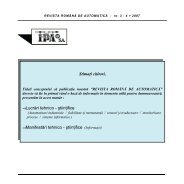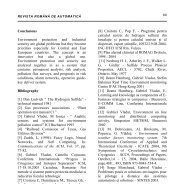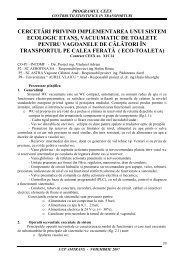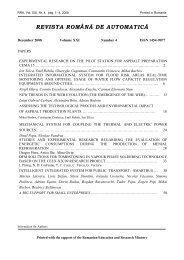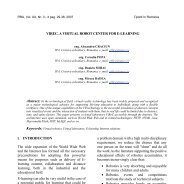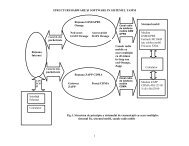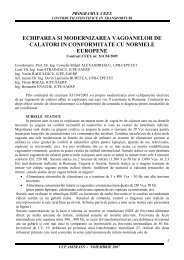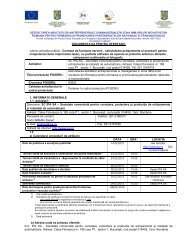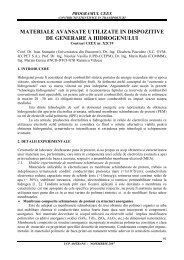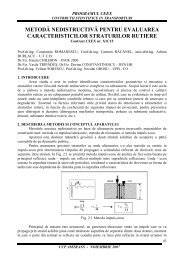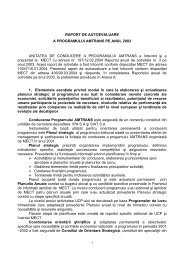0_ CUPRINS - IPA SA
0_ CUPRINS - IPA SA
0_ CUPRINS - IPA SA
You also want an ePaper? Increase the reach of your titles
YUMPU automatically turns print PDFs into web optimized ePapers that Google loves.
In the following we are going to do a statistical analysis on 5 groups of distances, from<br />
0,15km to 2,9km, from 500 to 500m, for 29 level differences, determined through GPS<br />
technology and measured in stages IV - VII.<br />
Out of the 29 differences, 24 differences from the first four groups fall within the<br />
tolerance of + / - 30mm the situation being the following on groups of distances:<br />
- gr. I, distances from 150m to 500m, has four differences with values between -7mm to<br />
+26 mm with a medium difference value of 13.3 mm;<br />
- gr. II, distances from 500m to 1000m, has nine differences with values between -16mm<br />
to +17mm with a medium difference value of 7,1mm;<br />
- gr. III, distances from 1000m la 1500m, has eight differences with values between -<br />
29mm to +29mm with a medium difference value of 13,4mm;<br />
- gr. IV, distances from 1500m to 3000m, has three differences with values between<br />
+25mm to +31mm for a distance of 2,9km, with a medium difference value of 28,0mm;<br />
In gr.V there are 5 distances, from the 29 analysed, that overpass the tolerance of +/-<br />
30mm, with values between 2mm and 8mm.<br />
In gr.VI we have the two cl.B points with wrong ellipsoid marks, with the values<br />
mentioned before , levels that influence the precision of the geometrical quasi-geoide that is in<br />
train of construction.<br />
Analyzing this group of measurements, we can say with certainty that for distances up to<br />
1500m, with normal precautions of design and location of control points and of measuring the<br />
antenna height with certainty, differences in level measured by GPS technology provides easy fit<br />
into tolerance + / - 30mm. For longer distances, up to about 3000m, the above entry in tolerance<br />
can be achieved in good condition by taking additional measures in the design phase. However<br />
for listing permanent GNSS stations located during the year 2009 it is advisable to keep the same<br />
method used for determining the levels during 2009.<br />
References<br />
1. Demidovich, B.P. & Maron, I.A.: Computational Mathematics. Mir Publishers, 1981.<br />
2. Dragomir, V., Ghiţau, D., Mihailescu, M., Rotaru, M.: Teoria Figurii Pamantului, E.T., 1977<br />
3. Dragoescu, I., Radulescu, F., Nacu, V., Stiopol, D.: Participarea Romaniei la intocmirea<br />
hartilor gradientilor orizontali ai miscarii verticale ale scoartei terestre pentru zona Carpato-<br />
Balcanica si pentru zona statelor est-europene. Analele IGFCOT, vol.X, 13-24 pp, 1989.<br />
4. Fotescu, N. & S`vulescu, C.: Teoria Erorilor. Litografie, ICB, 1988.<br />
5. Helmert, F.R.: Die mathematischen und physikalischen Theorien der höheren Geodäsie.<br />
G.G.Teubnez Verlag, Leipzig, 1880 ]i 1962.<br />
6. Nacu, V., Radulescu, F., Mateciuc, D., Stiopol, D.: Study of the deformation parameters in<br />
Gruiu-Caldarusani geodynamic polygon. XXIII General Assembly of European<br />
Seismological Commission, Activity Raport 1990-1992, 345-348 pp., Proceedings, vol II,<br />
Prague, Checkoslovakia,1992.<br />
7. Nacu, V., Radulescu, F., Mateciuc, D.: Horizontal deformations in the Gruiu-Caldarusani<br />
geodynamic polygon of Romania, Rev. Roumaine de Geophysique 37, 1993.<br />
8. Nacu, V., Mateciuc, D., Moldoveanu, C, Ilies, A.: Horizontal deformations in the Gruiu<br />
Caldarusani Test - Polygon of Romania. Mitteilungen aus den Geodätischen Instituten der<br />
Rheinischen Friedrich - Wilhelms - Universität Bonn, 1994.<br />
53



